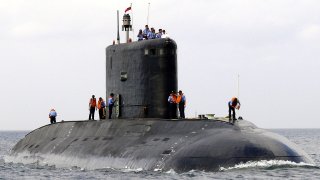Russia's Kilo-Class Submarine Is Called the 'Black Hole' For a Reason
Originally known as Project 877, the Kilo is an attack submarine that was designed for anti-shipping and anti-submarine operations in somewhat shallow water.
The Russian invasion of Ukraine has rekindled interest in the Russian military arsenal. Mostly, the interest has been focused on Russia’s land and air-based arsenal, as the Russo-Ukraine War has become a land-based war of attrition. Much has been made of Russia’s tank and armored vehicle fleets, for example. But attention has also been paid to Russia’s aircraft, Sukhoi and MiG aircraft, for example. And to a lesser extent, interest is being paid to Russian naval assets, who have participated in the conflict, albeit in a more peripheral role.
One Russian naval asset that has seen action in the Russo-Ukraine War is the Kilo-class submarine, a Soviet-era design that has long since become outdated – but remains adequate enough to compete against the Ukrainian naval defense systems.
The History of the Kilo-Class Submarine
The Kilo is notable in that it’s diesel-electric powered.
Whereas U.S. submarines, and even many Russian submarines, have adopted nuclear power plants, the Kilo still relies upon diesel-electric. The downside here, of course, is reduced endurance. Whereas a nuclear submarine can stay at sea indefinitely, the Kilo has a 45-day-at-sea endurance.
Whereas a nuclear submarine can traverse the globe, the Kilo is limited to just 400 nautical miles submerged (or up to 7,500 nautical miles while snorkeling). The range won’t cut it if you’ve taken on the role of world police (ala the USA). But if you’re just trying to impose yourself upon your eastern neighbors, the Kilo’s range will suffice.
The Kilo submarine was designed in the 1970s and first built in 1980. In total, 73 Kilos have been built while 64 are still active. One Kilo was lost to accident, one was preserved, and sixteen have been retired. But by and large, the Kilos that have been built are still in action.
“Russia’s Kilo-class diesel-electric submarine is one of the most successful naval programs in modern history,” wrote Eric Wertheim for the U.S. Naval Institute. “More than 70 Kilo-class units have been built during the past 40-plus years, and more than 60 remain in service with the navies of Algeria, China, India, Iran, Myanmar, Poland, Vietnam, and Russia. New and improved models are still being built, with deliveries planned well into the future.”

The Evolution of the Kilo
Originally known as Project 877, the Kilo is an attack submarine that was designed for anti-shipping and anti-submarine operations in somewhat shallow water. The design phase began in 1974 in the Soviet Union, at the Rubin Design Bureau. While the Kilo has been in continuous production ever since the early 1980s, the design has been updated and modernized in an effort to maintain the sub’s relevance.
“Construction has taken place at multiple Soviet/Russian shipyards,” Wertheim wrote, “progressing from the 877 design in the 1980s to the lengthened 636 design in the 1990s. The 636, often called the improved Kilo or Kilo II submarine, incorporated across-the-board enhancements.”
The enhancements? A quieter drive, improved propulsion system, and increased automation. The Soviet-era Kilo was brought into the twenty-first century. And upgrades have continued into the 21st century. In the 2010s, the Kilo was further refined into what is known as the Kilo Project 636.3, also known as the Improved Kilo II. The Improved Kilo II was first delivered to the Russian fleet between 2014 and 2016. Orders to the Pacific fleet began arriving in late 2019 and are expected to continue through 2025. And by all accounts, the new 636.3 is a capable submarine.

“The modern 636.3 design displaces roughly 2,350 tons surfaced and 3,100 tons submerged,” Wertheim wrote. “Although some sources place that number as high as 3,950 tons. Improved Kilo II submarines measure 242 feet long with a 32.5-foot beam and 20-foot draft.” The newest Kilos rely on two diesel generations featuring a single seven-bladed fixed-pitch propeller. The propulsion system allows for a top speed of 17 knots when surfaced, and 20 knots when submerged. The Kilo is believed to have a maximum diving depth of 984 feet.
The submarine is supposedly quite stealth, with some U.S. naval experts referring to the sub at some point as the 'black hole.'
The Weaponry of the Kilo
The Kilo is outfitted with six 21-inch bow torpedo tubes, which can be used to launch either torpedoes or naval mines. The Kilo’s torpedo tubes can even be used to launch Kalibr/Klub missiles for long-range land attacks, or anti-ship attacks. Reportedly, the Kilo was used for long-range attacks against ISIS back in 2015. More recently, Kilos lurking in the Black Sea have been used to attack land-based targets in Ukraine.
After the sinking of the Russian cruiser Moskva in April 2022 by Ukranian forces, the Black Sea Fleet was ordered not to sail into Ukrainian waters – with the exception of the Kilo, which was allowed to patrol the waters off Ukraine as usual. One Kilo was severely damaged while drydocked, however, from a Ukrainian Storm Shadow missile strike in Sevastopol.
Harrison Kass is the Senior Editor and opinion writer at 19FortyFive. An attorney, pilot, guitarist, and minor pro hockey player, Harrison joined the US Air Force as a Pilot Trainee but was medically discharged. Harrison holds a BA from Lake Forest College, a JD from the University of Oregon, and an MA from New York University. Harrison listens to Dokken.
All images posted are Creative Commons.


